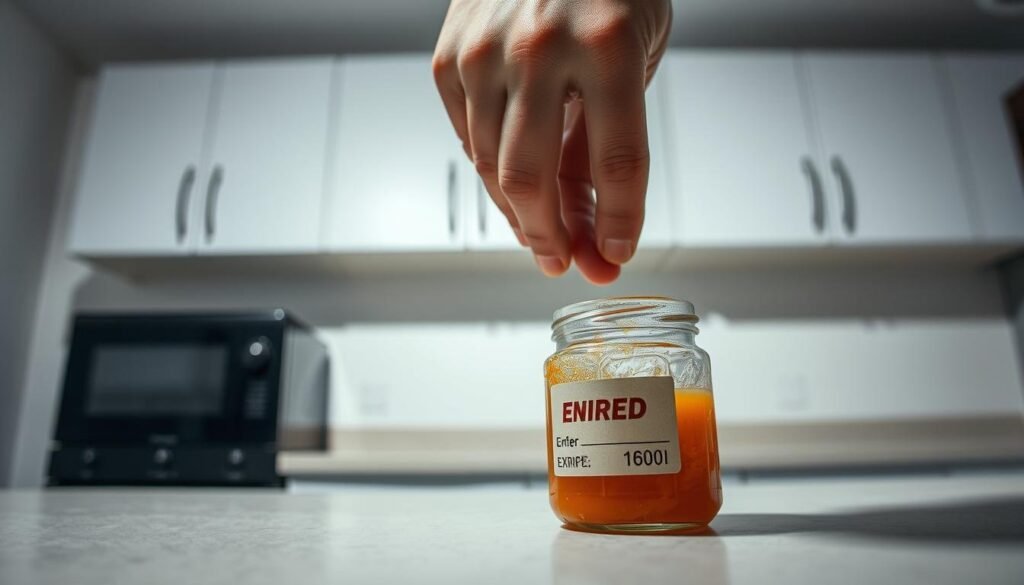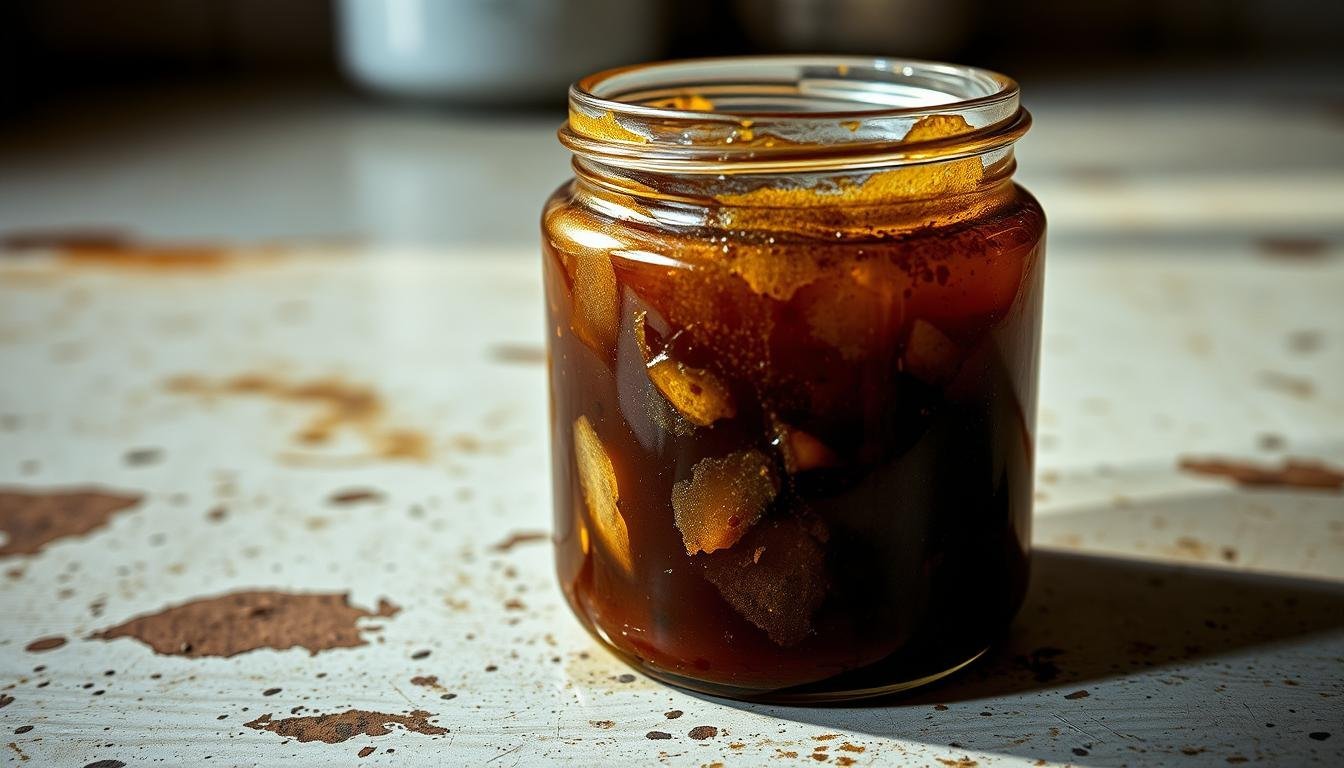Have you ever wondered if it’s safe to eat jelly after its expiration date? It’s a valid concern. Expired jelly can impact its quality and safety.
Expiration dates on jelly can be confusing. Some think they’re strict rules, while others see them as guidelines. The truth is somewhere in between.
This article will look into the risks of eating jelly past its expiration date. We’ll cover expiration dates, signs of spoilage, and how to store jelly to keep it fresh.
Contents
- 1 Understanding Jelly Expiration Dates
- 2 Can You Eat Jelly After Expiration Date?
- 3 Signs Your Jelly Has Gone Bad
- 4 Proper Storage Methods to Extend Jelly Shelf Life
- 5 Understanding Jelly Safety
- 6 FAQ
- 6.1 What does the "Best By" date on jelly mean?
- 6.2 How can I tell if my jelly has gone bad?
- 6.3 Can I still eat jelly after its expiration date if it has been stored properly?
- 6.4 How should I store opened jelly to extend its shelf life?
- 6.5 Is there a difference in shelf life between homemade and store-bought jelly?
- 6.6 Can freezing extend the shelf life of jelly?
Understanding Jelly Expiration Dates
To enjoy your jelly at its best, knowing the expiration date is key. These dates are not random. They show when the manufacturer promises the jelly will be fresh and of good quality.
“Best By” and “Use By” labels are common on food, including jelly. But they mean different things.
Difference Between “Best By” and “Use By” Dates
“Best By” means the jelly’s quality peaks on that date. It’s about the taste, texture, and look. “Use By” is stricter. It’s the last day to use the jelly safely and at its best.
- Best By: Refers to the quality of the jelly. It’s about the product’s taste, texture, and appearance.
- Use By: Indicates the safety aspect. It’s the last date recommended for the consumption of the product.
Knowing these dates helps you decide when to eat jelly. “Best By” is about quality, while “Use By” is about safety. But, jelly is usually safe to eat after these dates if stored right.
To keep your jelly fresh longer, follow storage tips. Unopened jelly can last a while because of its sugar and acidity. These help preserve it.
By understanding expiration dates, you can enjoy your jelly at its best. And you’ll know it’s safe to eat.
Can You Eat Jelly After Expiration Date?
Before you eat that jar of jelly past its expiration date, it’s important to know the risks. The safety of eating jelly after its expiration date depends on several factors. These include how it has been stored, the type of jelly, and visible signs of spoilage.
Storage conditions are key to keeping jelly safe and good to eat. Jelly exposed to heat, light, or moisture can spoil faster than properly stored jelly.
Impact of Storage Conditions on Jelly’s Shelf Life
Proper storage can make jelly last longer. Here are some important storage tips:
- Keep jelly in a cool, dry place, away from direct sunlight.
- Ensure the jar is tightly sealed after each use.
- Avoid storing jelly near heat sources or in humid environments.

The type of jelly also affects its shelf life. Jellies with more sugar or preservatives might last longer. But, even with good storage, always check for spoilage signs before eating.
Signs of bad jelly include mold, off smells, or changes in texture and color. If you see these, it’s best to throw the jelly away.
When it comes to food safety, it’s safer to be careful with expired foods, like jelly. The expiration date is a guide, not a rule. Your judgment, along with proper storage and checking for spoilage, will help you decide.
Signs Your Jelly Has Gone Bad
Before you eat jelly, make sure it’s not spoiled. Expired jelly doesn’t always mean it’s bad. But, there are signs to check if it’s safe to eat.
Mold is a clear sign of spoilage. If you see fuzzy growth on the jar or around the lid, throw it away. Mold can be green, white, or black. It looks like a fuzzy layer or spots. Mold growth means the jelly is bad and not safe to eat.
An off smell is another warning sign. Fresh jelly smells sweet and fruity. If it smells sour or sharp, it might be spoiled. This smell change happens when the jelly’s sugar breaks down.
Changes in texture or appearance also warn of spoilage. If the jelly is too thick, slimy, or separated, it’s bad. Also, if you see sediment at the bottom or if it’s darkened a lot, it’s best to throw it away.
Always check your jelly before eating it, especially if it’s past its expiration date. Looking for these signs helps you know if your jelly is still good or if it’s time to get new one.
Proper Storage Methods to Extend Jelly Shelf Life
Following a few simple storage tips can greatly extend your jelly’s shelf life. It’s key to keep jelly in good condition and safe to eat.
For unopened jars, store them in a cool, dry spot, away from sunlight. Once a jar is opened, it needs to go in the fridge. This slows down the jelly’s breakdown.
- Store unopened jelly jars in a cool, dry place.
- Keep jelly away from direct sunlight.
- Once opened, store jelly jars in the refrigerator.
- Always use a clean utensil when scooping out jelly to prevent contamination.
- Tightly seal the jar after each use.
Good storage conditions are crucial for jelly’s shelf life. Here’s a quick guide on how to store it right:
| Storage Condition | Unopened Jelly | Opened Jelly |
|---|---|---|
| Temperature | Cool, dry place | Refrigerated |
| Light Exposure | Avoid direct sunlight | Avoid direct sunlight |
| Utensil Hygiene | Not applicable | Use clean utensils |
By sticking to these storage tips, you can enjoy your jelly longer. This way, you keep it tasting great and ensure safe jelly consumption.
Understanding Jelly Safety
It’s important to check the expiration date before eating jelly. This date shows when the jelly is still safe to eat. If it’s past this date, it’s safer to throw it away.
Storing jelly right can make it last longer. Keep it in a cool, dry spot, away from sunlight. Always check for mold or a bad smell before eating, even if it’s not past the expiration date.
By watching the expiration date and storing jelly correctly, you can enjoy it safely. But, it’s best not to eat jelly after its expiration date to avoid health risks.
FAQ
What does the "Best By" date on jelly mean?
The “Best By” date on jelly shows when the jelly tastes best. It doesn’t mean the jelly is unsafe. It just means the jelly will taste and feel its best until that date.
How can I tell if my jelly has gone bad?
Look for mold, sediment, or an unusual color to see if jelly has spoiled. A sour or bad smell also means it’s gone bad. Always check the jelly’s look and smell, especially after its expiration date.
Can I still eat jelly after its expiration date if it has been stored properly?
Yes, you can eat jelly after its expiration date if it’s been stored right. Keep it cool, dry, and away from sunlight. Make sure the jar is sealed tight. But always check for signs of spoilage before eating.
How should I store opened jelly to extend its shelf life?
Store opened jelly in the fridge to keep it longer. Always seal the jar tight after use. This keeps the jelly fresh and safe for longer.
Is there a difference in shelf life between homemade and store-bought jelly?
Homemade jelly lasts less than store-bought jelly because it lacks preservatives. Homemade jelly should be in the fridge and eaten within weeks. Store-bought jelly can last longer if stored right in a pantry.
Can freezing extend the shelf life of jelly?
Freezing jelly is not the best idea. It can make the jelly watery or separate when thawed. If you must freeze it, use an airtight container. Check its quality after thawing before eating.

Hello, I am Bellamy George, a certified nutritionist and food safety specialist from Springfield, IL. With a degree in Food Science, I share research-backed insights on edible foods, seeds, and seafood for safe, informed eating.

